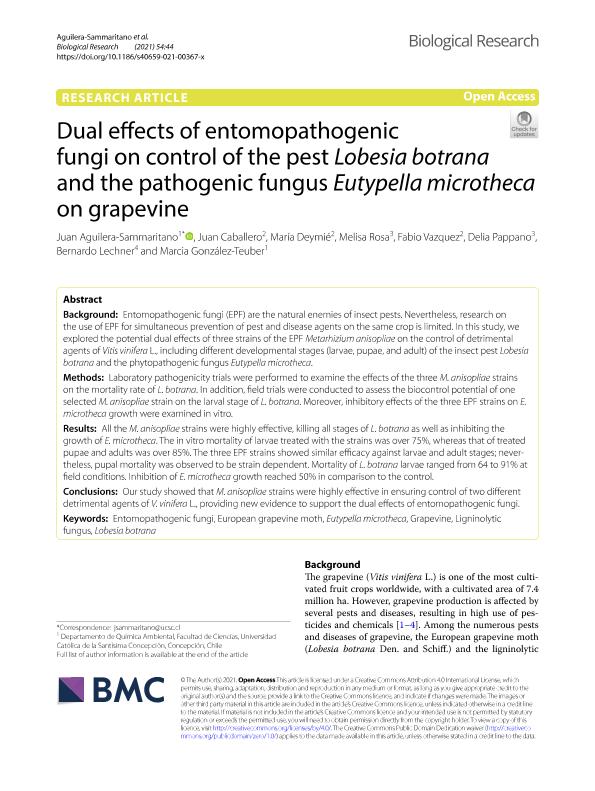Mostrar el registro sencillo del ítem
dc.contributor.author
Aguilera Sammaritano, Juan Alberto

dc.contributor.author
Caballero, Juan Jose

dc.contributor.author
Deymié Terzi, María Celina

dc.contributor.author
Rosa, Melisa
dc.contributor.author
Vazquez, Fabio

dc.contributor.author
Pappano, Delia Beatriz

dc.contributor.author
Lechner, Bernardo Ernesto

dc.contributor.author
González Teuber, Marcia
dc.date.available
2022-03-15T10:11:15Z
dc.date.issued
2021-12-13
dc.identifier.citation
Aguilera Sammaritano, Juan Alberto; Caballero, Juan Jose; Deymié Terzi, María Celina; Rosa, Melisa; Vazquez, Fabio; et al.; Dual effects of entomopathogenic fungi on control of the pest Lobesia botrana and the pathogenic fungus Eutypella microtheca on grapevine; Sociedad de Biología de Chile; Biological Research; 54; 1; 13-12-2021; 1-10
dc.identifier.issn
0716-9760
dc.identifier.uri
http://hdl.handle.net/11336/153379
dc.description.abstract
Background: Entomopathogenic fungi (EPF) are the natural enemies of insect pests. Nevertheless, research on the use of EPF for simultaneous prevention of pest and disease agents on the same crop is limited. In this study, we explored the potential dual effects of three strains of the EPF Metarhizium anisopliae on the control of detrimental agents of Vitis vinifera L., including different developmental stages (larvae, pupae, and adult) of the insect pest Lobesia botrana and the phytopathogenic fungus Eutypella microtheca. Methods: Laboratory pathogenicity trials were performed to examine the effects of the three M. anisopliae strains on the mortality rate of L. botrana. In addition, field trials were conducted to assess the biocontrol potential of one selected M. anisopliae strain on the larval stage of L. botrana. Moreover, inhibitory effects of the three EPF strains on E. microtheca growth were examined in vitro. Results: All the M. anisopliae strains were highly effective, killing all stages of L. botrana as well as inhibiting the growth of E. microtheca. The in vitro mortality of larvae treated with the strains was over 75%, whereas that of treated pupae and adults was over 85%. The three EPF strains showed similar efficacy against larvae and adult stages; nevertheless, pupal mortality was observed to be strain dependent. Mortality of L. botrana larvae ranged from 64 to 91% at field conditions. Inhibition of E. microtheca growth reached 50% in comparison to the control. Conclusions: Our study showed that M. anisopliae strains were highly effective in ensuring control of two different detrimental agents of V. vinifera L., providing new evidence to support the dual effects of entomopathogenic fungi.
dc.format
application/pdf
dc.language.iso
eng
dc.publisher
Sociedad de Biología de Chile

dc.rights
info:eu-repo/semantics/openAccess
dc.rights.uri
https://creativecommons.org/licenses/by-nc-sa/2.5/ar/
dc.subject
ENTOMOPATHOGENIC FUNGI
dc.subject
EUROPEAN GRAPEVINE MOTH
dc.subject
EUTYPELLA MICROTHECA
dc.subject
GRAPEVINE
dc.subject
LIGNINOLYTIC FUNGUS
dc.subject
LOBESIA BOTRANA
dc.subject.classification
Micología

dc.subject.classification
Ciencias Biológicas

dc.subject.classification
CIENCIAS NATURALES Y EXACTAS

dc.title
Dual effects of entomopathogenic fungi on control of the pest Lobesia botrana and the pathogenic fungus Eutypella microtheca on grapevine
dc.type
info:eu-repo/semantics/article
dc.type
info:ar-repo/semantics/artículo
dc.type
info:eu-repo/semantics/publishedVersion
dc.date.updated
2022-01-27T18:14:11Z
dc.identifier.eissn
0717-6287
dc.journal.volume
54
dc.journal.number
1
dc.journal.pagination
1-10
dc.journal.pais
Chile

dc.journal.ciudad
Santiago de Chile
dc.description.fil
Fil: Aguilera Sammaritano, Juan Alberto. Consejo Nacional de Investigaciones Científicas y Técnicas; Argentina. Universidad Católica de la Santísima Concepción; Chile
dc.description.fil
Fil: Caballero, Juan Jose. Universidad Nacional de San Juan. Facultad de Ingeniería. Instituto de Biotecnología; Argentina
dc.description.fil
Fil: Deymié Terzi, María Celina. Universidad Nacional de San Juan. Facultad de Ingeniería. Instituto de Biotecnología; Argentina. Consejo Nacional de Investigaciones Científicas y Técnicas; Argentina
dc.description.fil
Fil: Rosa, Melisa. Universidad Nacional de San Juan; Argentina
dc.description.fil
Fil: Vazquez, Fabio. Universidad Nacional de San Juan. Facultad de Ingeniería. Instituto de Biotecnología; Argentina
dc.description.fil
Fil: Pappano, Delia Beatriz. Universidad Nacional de San Juan; Argentina
dc.description.fil
Fil: Lechner, Bernardo Ernesto. Consejo Nacional de Investigaciones Científicas y Técnicas. Oficina de Coordinación Administrativa Ciudad Universitaria. Instituto de Micología y Botánica. Universidad de Buenos Aires. Facultad de Ciencias Exactas y Naturales. Instituto de Micología y Botánica; Argentina
dc.description.fil
Fil: González Teuber, Marcia. Universidad Católica de la Santísima Concepción; Chile
dc.journal.title
Biological Research

dc.relation.alternativeid
info:eu-repo/semantics/altIdentifier/url/https://biolres.biomedcentral.com/articles/10.1186/s40659-021-00367-x
dc.relation.alternativeid
info:eu-repo/semantics/altIdentifier/doi/http://dx.doi.org/10.1186/s40659-021-00367-x
Archivos asociados
